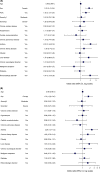Incidence and risk factors for persistent symptoms in adults previously hospitalized for COVID-19
- PMID: 34351016
- PMCID: PMC8444748
- DOI: 10.1111/cea.13997
Incidence and risk factors for persistent symptoms in adults previously hospitalized for COVID-19
Abstract
Background: The long-term sequalae of COVID-19 remain poorly characterized. We assessed persistent symptoms in previously hospitalized patients with COVID-19 and assessed potential risk factors.
Methods: Data were collected from patients discharged from 4 hospitals in Moscow, Russia between 8 April and 10 July 2020. Participants were interviewed via telephone using an ISARIC Long-term Follow-up Study questionnaire.
Results: 2,649 of 4755 (56%) discharged patients were successfully evaluated, at median 218 (IQR 200, 236) days post-discharge. COVID-19 diagnosis was clinical in 1291 and molecular in 1358. Most cases were mild, but 902 (34%) required supplemental oxygen and 68 (2.6%) needed ventilatory support. Median age was 56 years (IQR 46, 66) and 1,353 (51.1%) were women. Persistent symptoms were reported by 1247 (47.1%) participants, with fatigue (21.2%), shortness of breath (14.5%) and forgetfulness (9.1%) the most common symptoms and chronic fatigue (25%) and respiratory (17.2%) the most common symptom categories. Female sex was associated with any persistent symptom category OR 1.83 (95% CI 1.55 to 2.17) with association being strongest for dermatological (3.26, 2.36 to 4.57) symptoms. Asthma and chronic pulmonary disease were not associated with persistent symptoms overall, but asthma was associated with neurological (1.95, 1.25 to 2.98) and mood and behavioural changes (2.02, 1.24 to 3.18), and chronic pulmonary disease was associated with chronic fatigue (1.68, 1.21 to 2.32).
Conclusions: Almost half of adults admitted to hospital due to COVID-19 reported persistent symptoms 6 to 8 months after discharge. Fatigue and respiratory symptoms were most common, and female sex was associated with persistent symptoms.
Keywords: COVID-19; PASC; asthma; long COVID; post-COVID Condition; post-COVID Syndrome; postacute sequelae SARS-CoV-2 infection; risk factors.
© 2021 John Wiley & Sons Ltd.
Conflict of interest statement
J. Genuneit reports working as a project manager of unrestricted research grants on the composition of breast milk to the Ulm University and Leipzig University. M.G. Semple reports grants from DHSC National Institute of Health Research UK, grants from Medical Research Council UK, grants from Health Protection Research Unit in Emerging & Zoonotic Infections, University of Liverpool outside the submitted work; he also reports a minority ownership at Integrum Scientific LLC, Greensboro, NC, USA outside the submitted work. T. Vos reports personal fees for work on Global Burden of Disease Study from Bill and Melinda Gates Foundation, outside the submitted work. All other authors report no relevant conflict of interests.
Figures





References
-
- Pritchard MG. COVID‐19 symptoms at hospital admission vary with age and sex: ISARIC multinational study. medRxiv. 2020:2020.2010.2026.20219519. - PubMed

